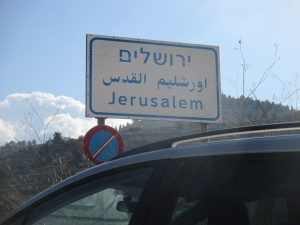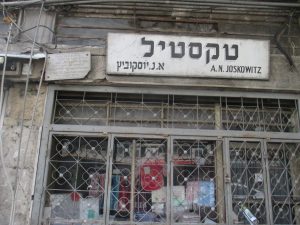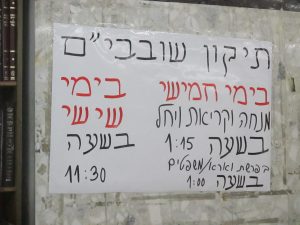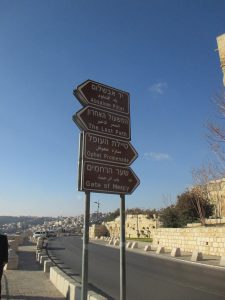Signs of the Times in Eretz Yisrael

Psst! I have a secret for all of my readers: I am an amateur “signologist.” Hmm, I wonder whether the word “signology” really exists.
Well, it really should, you know! An otherwise-simple sign could be the portal to a whole new world of meaning. My pictures in this issue should prove that point very well!

Israelis seem to have a keen interest in what they perceive to be the crux of the message that a particular sign ends up conveying. Whether it is a trademark smiling goat in the “yellow” sign at Ben Gurion Airport (note that the smile is a very human one, although the rest of the countenance is a definitely goatish one); or the “Lakewood bus (# 732)” at a bus stop on Rechov Malchei Yisrael; or the announcement of my dear rebbi’s petirah posted on a wall somewhere in Yerushalayim; or the sign (in English) appearing at Kever Rochel indicating the direction of one’s prayerful kavanos [toward the Kodesh Kodoshim in Yerushalayim]—and a similar sign in Hebrew emphasizing an understandably different direction at the grave of Rabbi Meir Ba’al Haness in Tiveryah); or a “Shana Tovah!” sign on a city bus about to arrive at the Kosel; or the admonition (articulated in both Lashon HaKodesh and English) to be careful to speak only words of Shabbos holiness on the Day of Rest itself. . .why, the list goes on and on!

Indeed, many of the signs one sees in our Holy Land in general—and in Yerushalayim in particular—relate directly to us as frum Yidden. In Kever Rochel, for example, a stone tablet ensconced in the wall of the building across Rochel’s matzeivah near an aron hakodesh tells us that the luchos over that aron, as well as the sign itself, were hewn from rock taken from Har Sinai. “You should stand up before the elderly,” proclaims a sign on a city bus (in the language of the Torah, of course). And how about the sign atop a rest-stop that declares “Mi La’Shem Eilai”?

As for commerce, it is nearly impossible to ignore the signs that announce various businesses in the Geulah-Meah Shearim area. Unfortunately, many of the signs that used to tug at my heartstrings in past years have unfortunately been taken down and replaced with more up-to-date pieces. You can distinguish between a very old sign (like the “textiles” sign appearing over the A. N. Joskowitz store in Geulah) and one of a more recent vintage, since the older one either has no phone number on the sign—or if it does, the 02 Yerushalayim area code is missing. Furthermore, there are usually just six (or fewer) digits in the telephone number, not seven as it would contain today. If just “2” is listed as the area code, we may be dealing with a sign of intermediate age, whereas if “02” is listed, the sign is more or less contemporary. Interestingly enough, the textile store cited above is housed in a historic building, as the very old sign (praising the ‘nashim rachmaniyos’ of the Ezer Yoldos Society) positioned on one side of the store sign bears witness.

(As an aside: The sincerity of many signs sometimes overrides syntactical and grammatical errors. For instance: The hartzige hospitality that my Yarchei Kallah group felt while attending a meeting with the mayor of Bnei Brak made it seem almost desirable to be “hospitalized” [!] there. Other signs, such as the one written half in Hebrew and half in Chinese [also in Bnei Brak], have the power to rivet your attention to them!

Ah yes, signs of the time. The Eretz Yisrael-bound traveler needs to reconsider these nearly forgotten emblems as entryways to the past, gauges of the goodness of Klal Yisrael, and portents of hope for the future of the am hanivchar. For these signs reflect the very goodness and tenacity of the People of Israel, thereby serving as a connection between a vibrant past and a hopeful future!
>>>>>>>>>>>>>>>>>>>>>>>>>>>>>>>>>>>>>>>>>>>>>>>>>>>>>>>>>>>
Questions or comments? Please send these to me at hillyarm@yeshivanet.com. Many thanks, dear readers!
You must be logged in to post a comment.